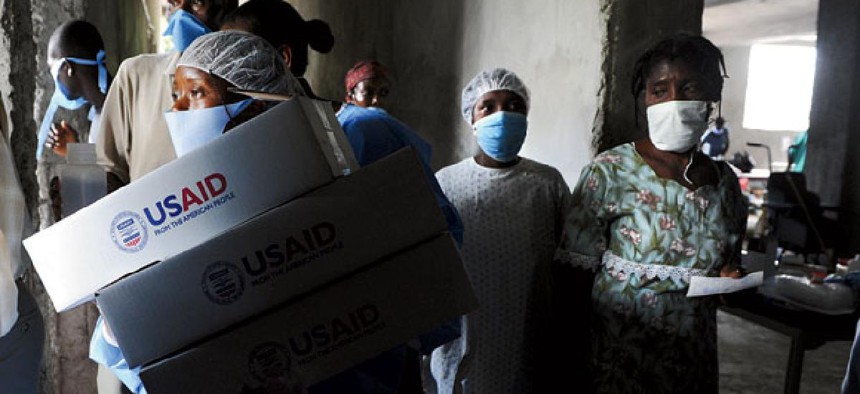
USAID photo
During humanitarian crises, entire populations generally have to put full faith in the system to set things right, leaving little time for the bureaucracy that can plague federal management.
This kind of pressure presents a host of challenges for government aid groups. Are they properly employing the latest technology to identify and address danger zones? Do they have the resources they need to set up long-term, sustainable solutions? And would failure spell doom for handling larger crises?
Consider Haiti. Ten months after a devastating earthquake suddenly leveled much of the impoverished Caribbean nation in January 2010, a more gradual but no less dangerous threat took hold: cholera. A United Nations peacekeeper appeared to unknowingly introduce a strand of the bacteria to citizens still reeling from the quake’s destruction.
The disease, which spreads via contaminated water sources, traveled swiftly in Haiti, one of the only countries in the world where access to modern sanitation has worsened in the past two decades. By February, cholera had killed more than 7,000 Haitians and sickened more than 526,000. Now it threatens to spread beyond the country’s borders.
The Health Systems Reconstruction Office at the Centers for Disease Control and Prevention was formed shortly after the quake to help CDC respond quickly to countries in crisis. Operating out of a tent city on the U.S. embassy compound in Port-au-Prince, CDC delegates have been collaborating with the Haitian Ministry of Public Health and other organizations to stop the spread of cholera.
The first six weeks were “really rough,” says Dr. Jordan W. Tappero, who heads the HSR office. Haiti had never seen cholera before. There was, Tappero recalls, no information anywhere in the country about how to treat it or train health care professionals to respond to it: “None in Creole; none in French.” CDC had to develop its own materials and distribute them to Haitian health professionals.
CDC partnered with international groups to develop an active surveillance system with the cooperation of the Haitian government that would allow for near-daily reporting on the disease and treatment. By January 2011, the mortality rate for the country’s cholera victims had fallen from 5 percent to less than 1 percent—a benchmark in epidemiology—but it has since risen above that threshold.
While the government still touts that progress, critics argue cholera relief in Haiti should have been quicker and more thorough. Dr. Michael McDonald heads the U.S. Resilience System, a public-private consortium that promotes quick response. He says government institutions often falter when forced to confront immediate, high-stakes situations.
In Haiti, he says, his team detected the first signs of potential for disease outbreaks—particularly diarrheal illnesses such as cholera—two and a half months after the earthquake and long before the epidemic took hold.
McDonald’s team alerted CDC as well as the U.S. Agency for International Development. “The answer back was, ‘Don’t worry, we’ve got it covered,’ ” he says. “But we knew they didn’t have it covered, because we could see what was going on, and they had no clue.” He faults the U.S. government for its aloofness. “They’re mostly sitting in air-conditioned trailers and compounds and going out occasionally to photo ops, but they’re not going into a lot of these places,” McDonald says of federal aid workers.
Tappero acknowledges CDC does not send its own doctors out to treat the victims at the various sites, but says the U.S. government has helped open treatment centers across the country.
After the outbreak, McDonald’s group partnered with Haitian phone carriers to crowdsource text messages from Haitian citizens and rapidly identify afflicted regions—such as the remote northern village of Borgne—that weren’t on government aid workers’ radar. McDonald says they were able to respond to pleas for help within days, while the U.S. government took two to three weeks.
CDC tries to take a long view. Instead of focusing on quick responses to outbreaks, the agency aims to build up Haiti’s public health workforce by accrediting field epidemiology training programs. According to Tappero, the program will graduate the first two students from its two-year curriculum in 2013; many more students have passed through less intensive training programs.
“The U.S. government can’t be the Ministry of Health, nor do we want to be,” Tappero says. “We want to empower. We want to train. We want to work side by side. We want to build capacity and sustainability within the ministry.” He adds CDC’s goal is “to put ourselves out of business in Haiti.”
Tappero says an army of trained doctors can’t address the deeper, underlying problems with Haiti’s infrastructure. To truly contain the epidemic, which has already attacked the country in three separate waves with a fourth on the immediate horizon, would take a much larger amount of time and commitment from the United States. In the meantime, the summer rainy season looms, and with it, promises of yet another outbreak. Vaccination efforts in the country have been slowed due to
Haitian bureaucracy.
Despite their differences, Tappero and MacDonald agree on one thing: When it comes to crisis management, the U.S. government cannot fall victim to the same kind of gridlock.
NEXT STORY: Around Government






